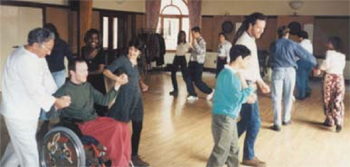Biodanza and Parkinson's Disease
von Gabriele Freyhoff -
Biodanza and Parkinson's Disease: Proposal of Motor Existential Rehabilitation by Rolando Toro Arañeda.
Parkinson’s disease is a progressive disorder of the central nervous system causing physical symptoms such as muscular rigidity and tremor by which it is most usually recognized. However, it affects the whole person’s existence producing distinct psychological symptoms also. Professor Toro found that the Biodanza System has produced beneficial effects and results with Parkinson’s patients.
About the author
Rolando Toro Arañeda is an anthropologist and psychologist from Chile. He was also a lecturer in Anthropologic Medicine of the School of Medicine of Chile where he researched and experimented in expansion of consciousness. He was also a professor in the Psychology of Art and Expression at the Institute of Aesthetics of the Catholic University and a Professor of the Inter-American Open University of Argentina. Creator of the Biodanza System forty years ago and researcher in psycho-somatic, Parkinson’s and Alzheimer diseases through the Biodanza System in Argentina, Brazil, Italy and Switzerland from 1974 until 1998 when he returned to Chile.
Currently he is the President of the International Biocentric Foundation, from which he is responsible for the teaching of the Biodanza System in Schools of Biodanza worldwide
See article – Biodanza – The Dance of life – by Karen Woodley – Positive Health April 1999. For information about the Biodanza System please contact Biodanza UK – Patricia Martello: 48 Clifford Ave, London SW14 7BP, UK. Tel: 020 8392 1433.
This article was taken from a paper written by Rolando Toro about his work with Parkinson’s patients; it has been adapted, translated and edited by Patricia Martello, Director of the School of Biodanza in the UK, with the collaboration of Anne Varco, Karen Woodley and Iain Murdoch, Students of the School of Biodanza in the UK.
Workshop with a small group of young people with various types of motor disabilities. Organized by Hammersmith and Fulham Action for Disability
 What is the Biodanza System?
What is the Biodanza System?
From a passionate desire to humanize medicine, to get away from the stereotype of the sick patient and to enable peoples’ instincts to be reborn, Rolando Toro Arañeda devised a system using the universal language of music which is capable of eliciting emotional responses, and dance. He created a subtle combination of music, dance and exercises to stimulate vitality, creativity and communication among people, calling the system Biodanza because movement stimulated by the emotions has a profound effect on our biology and, in fact, in our lives.
Some exercises stimulate the autonomic nervous system leading to either stimulating or calming effects. Yet others are ‘enlightening’ enabling participants to gain a deeper perception of themselves and their style of communication with others. Toro’s hypothesis is that we have lost much of our instinctive unity with ourselves and with nature, hence Biodanza seeks to re-integrate people through the arousal of the emotions of affection.
Because the exercises bring about psychological and physiological changes in the body, cells repair themselves thus re-establishing homeostasis. The original instincts with which we were born such as our instinctive expressions of creativity, vitality and compassion may be relearned within Biodanza classes.
These changes are brought about within a group through what Rolando calls ‘Vivencia’ (from the German philosopher Wilhelm Dilthey on his book The Essence of Philosophy: Erlebnisse). The word vivencia has no direct English translation, but the best approximation is ‘A vivid experience with intensity’. It is an intense perception of being alive in the here and now. There are five lines of interconnected Vivencias, each designed to develop different aspects of the human being: Vitality, Sexuality, Creativity, Affectivity and Transcendence.
Different Biodanza groups cater for different needs, for example adults, the elderly, children, special needs such as Parkinson’s patients, the mentally ill, drug and alcohol abusers, etc.
Psychological symptoms of the patients
The symptoms of Parkinson’s disease increase under the effects of emotional situations of conflict or anxiety. There exists a neurological circuit in which the emotional and motor symptoms are in feedback. The common depressive state of physical incapability has the tendency of being progressive.
There also exists a diminishing of the immediate memory, of the capacity of thinking and the critic capacity. The progressive feeling of uselessness emphasizes the depression. The Parkinson’s patient suffers severe disturbances of his identity such as: feeling of no value, tendency of dependency, alteration of judgment of reality, difficulties of communication and lack of motivation of living. His lack of affectivity deteriorates due to his motor and expressive difficulties.
The Parkinson’s patient is not only a motor ill person; actually his own inner existence is severely ill (in the sense of illnesses of the existence by K Jaspers).
Traditional rehabilitation
The exercises of traditional rehabilitation are proposed to activate walking, correct posture, stimulate movements of the legs (bicycle) and global motricity. Other soft exercises of extension, prehension and coordination facilitate the manipulation of objects.
The system of biofeedback and autogenic training are also utilized with uncertain results or no results. The recommendation is that the patients participate in activities of daily life due to the efficacy that this has in rehabilitation of movement.
Rehabilitation of the patients with Parkinson’s disease through the Biodanza System
The fundamental difference between the traditional approaches with the approach of Biodanza is that with Biodanza the strong motivation to move exists. The traditional rehabilitation of the patients of Parkinson’s is mechanical, based on exercises imposed ‘from outside’ by the therapist. These procedures include machines in order to exercise certain movements. During a session of Biodanza the movements that the patients make are ordered ‘from inside’, impulsed by an emotional need.
The movements that the patients make during a session are complex, organic behaviours integrating the motor affective structure – ( Affective: The expression of affection. Motor: Movements integrating feeling with movement )
The patient adjusts with the joy of rhythm or makes simple movements of coordination in order to dance with another person.
Through certain exercises the patient is able to express a diversity of emotions. To express in a safe environment through different dances what they feel – integrating in this way ‘what I feel and what I do’ because as we know sometimes the person feels something and the body expresses something different. So the idea is to integrate and unite in simple exercises this human possibility.
The challenge of moving himself into group activities stimulates himself in order to make movements and gestures of interpersonal links. The rhythmic dances (Jazz, South American rhythms etc.) increase the humour, overcoming momentarily the depressive state. After a certain time the humour levels increase and stabilize.
The exercises of fluidity eliminate progressively the extra-pyramidal hypertone. The emotions of joy and affection activate the motor centres overcoming the tendency to acinesia. To make a simple dance demands changes in the motor schemes – the variation of the impulses of adaptation of each moment of the dance possess a very high complexity to the simple mechanic exercises.
Finally, the affective contact within the group re-establishes the communication and strengthens the consciousness of their own identity severely threatened by the disease. The self esteem and confidence increase progressively in each class when the patient can experiment autonomy in order to move, to dance and to express.
Hypothesis about the possible mechanisms of rehabilitation and healing of the patients of Parkinson’s disease through Biodanza system
We have observed amazing cases of rehabilitation of patients of Parkinson’s disease through the Biodanza system. The explicative hypothesis belongs without a doubt to the field of psychosomatic medicine. The starting point is the unitarian conception of the human organism in which the psyche and soma belong to the same systemic structure – the new stimulus of motor character induced by intense emotions change the levels of responses of the central nervous system and alter the production of neurotransmitters.
This new stimulus can generate collateral nervous circuits that reinforce each other progressively by feedback, establishing new schemes for the motricity. The neurochemic circuits induced by the emotions and by the new motor behaviours can integrate and restore global psychomotor functions. The motivation in order to act stimulates the cortical and cerebellum centres.
The studies of neurochemic anatomy of the ganglions of the base has allowed to establish numerous neurochemic circuits and localized the neurotransmitters that intervene as chemical mediators of the ganglions of the base in connection with motor cortex.
Considerations of the possible mechanisms that intervene in the rehabilitation through the Biodanza System
Biodanza is a system of human integration, organic renovation that facilitates the healthy organic functions and improve the quality of the style of life through the progressive induction of intense emotions (Vivencias) induced by music, dancing and exercises of group communication. These dances and exercises are organized according with the theoretical model based in biological, aetiological and psychological studies of the human being.
These studies have allowed us to have evidence that certain exercises united with strong emotions have specific effects on the organism. In this way exercises that represent a challenge have an ergotropic (sympathetic, adrenergic effect). Exercises that induce regression and relaxation have a tropotropic (parasympathetic, adrenergic effect).
Harmonizing exercises have an anxiolytic and tranquillizing effect (Gaba effect). Euphoric exercises with sensual nuances have anti-depressive effects, inhibitors of the OAM.
The proposal of Biodanza is not just to improve the inner states of the patients or a simple mechanical way of movement – the real aim is to give back to the patient the human condition, that is to say to make them feel the healthiest and loving part of themselves and to express it. We have received from patients treated with rehabilitation through the Biodanza system very positive feedback due to the increasing motivations towards life.
Some patients without the possibility to experience Biodanza suffer a very strong depression and a sort of acceptance of suffering of the disease. Through the progress and process with Biodanza the patients experiment during the class the connection with oneself, having intimacy with their own bodies and necessities as an ordinary man or woman and also the possibility to socialize and relink with people with affection, increasing the poetic quality of the expression among them-selves, giving a new vision of the human encounter.
Many of them have said that Biodanza changed their lives because it gave a new perception of the life, more sensitive, more healthy with latent talent that they discovered class by class. Biodanza offered the possibility to connect with the group as a centre of energy that creates equal opportunities of expressivity for all the members of the group in a non- competitive and safe environment. For many of them Biodanza is a re-discovery of life and a rehabilitation not just of Parkinson’s diseases but as a hope for human rehabilitation at existential level.
Gabriele Freyhoff
Biodanza-Ausbilderin und Kursleiterin in Köln
Hier mehr interessantes rund um das Thema "Trauma, Krankheit & Heilung" von Gabriele Freyhoff.
Eigene praktische Erfahrungen machen?


Und wenn Sie mehr lesen möchten:





